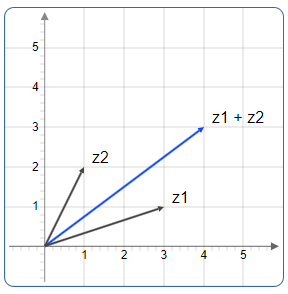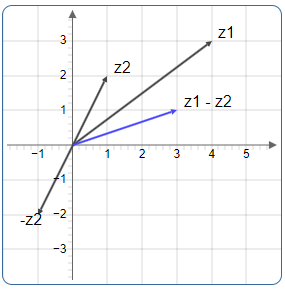Geometric addition and subtraction
Geometric addition and subtraction of complex numbers in the Gaussian number plane with examples
Addition in the Gaussian number plane
Complex numbers are added by adding the real parts and the imaginary parts separately. For the addition of the two complex numbers:
A complex number is uniquely defined by a pair of numbers \((a, b)\) or geometrically by a point in the Gaussian plane. Each pair of numbers can be assigned a unique vector.
This vector can be represented in the Gaussian plane by a line or an arrow with the starting point \(0\) and the end point \(z\).
The addition of two complex numbers \(z1\) and \(z2\) corresponds to the addition of the associated vectors in the Gaussian plane
Vectors are added by adding the components separately. The first component corresponds to the real part and the second to the imaginary part.
The following figure shows the complex numbers \(z1 = 3 + i\) and \(z2 = 1 + 2i\) and the visualized result of the complex addition.
Subtraction in the Gaussian Plane
The geometric subtraction of two complex numbers \(z_1\) and \(z_2\) is similar. It is true that complex numbers are subtracted by subtracting the real parts and imaginary parts separately - as well as subtracting vectors.
The subtraction of the vectors \(z_1\) and \(z_2\) carried out in practice such that to the vector of \(z_1\) is added the invers vector of \(z_2\) that is the vector \(-z_2\).
\(z_1- z_2 = z_1+ (-z_2)\)
The following figure shows the geometric subtraction
The difference \(z_1 - z_2\) can be represented by the vector from \(0\) to \(z_1 - z_2\) or also by the vector from \(z_2\) to \(z_1\) Both vectors have the same length, direction and orientation. That is, both vectors are the same.
The vectors are also identical from \(0\) to \(z_2\) and from \(z_1 - z_2\) to \(z_1\).
Depending on the one or the other representation may be beneficial.
|
|



